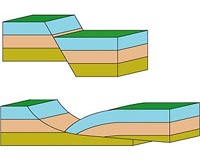| . |  |
. |
Cikangkareng, Indonesia (AFP) Sept 3, 2009 Rescue workers on Indonesia's Java island searched by hand Thursday for dozens of people trapped by a major 7.0-magnitude earthquake that killed at least 57, officials said. Police and soldiers were called in to help find people buried in their homes by earthquake-triggered landslides in a village in Cianjur district south of the capital Jakarta after the quake, officials said. Dozens of people were trapped under rubble, dirt and boulders in Cikangkareng village while over 5,000 people had been displaced by the quake, health ministry crisis centre head Rustam Pakaya said. Disaster management agency spokesman Priyadi Kardono said widespread damage in the lush, crowded area was hampering rescue efforts. "So far we are digging them out manually with hoes," Kardono said. In the village, the earthquake caused landslides that stripped hillsides bare and buried homes. Police, rescue workers and residents used their bare hands and improvised tools to uncover the dirt-covered bodies of people and livestock from underneath piles of rocks and earth. Heavy machinery was used to move stones amid fallen trees. "The village is in a valley and the landslide buried a dozen houses about 20 metres under. You can't see the roofs at all, everything is completely buried. The chance of anyone surviving is very, very small," Kardono said. President Susilo Bambang Yudhoyono and top ministers travelled to the disaster site to inspect the rescue effort and speak to victims. "What's important now is being responsive to the emergency... to save lives and to bury those who died," Yudhoyono was quoted as saying by state news agency Antara. Officials said the worst damage from the earthquake, which struck off the south coast of Java at around 3:00 pm (0800 GMT) Wednesday was in the districts of Cianjur, Garut and Tasikmalaya in West Java province. Mariani, a hospital staff member in Tasikmalaya, said medics had treated 43 people. "Two of them, a 43-year-old woman and a seven-year-old boy, died from serious head injuries after they were crushed under a collapsed wall. Their bodies were all covered with blood," she said. "The hospital floors shook so hard yesterday and patients and staff were shouting 'Allahu Akbar! Allahu Akbar! (God is greater)' as we rushed to get all the bedridden patients out of the building." The quake was also strongly felt in Jakarta, 200 kilometres (123 miles) from the epicentre, where panicked residents poured out of swaying office towers, shopping malls and homes as the tremors hit and at least one person was killed. Disaster agency official Maman Susanto said around 18,000 buildings were damaged in the quake, which was also felt in other Indonesian islands, including Bali and Sumatra. Australian Prime Minister Kevin Rudd said his country had offered assistance to neighbouring Indonesia to deal with the aftermath of the earthquake. The West Java provincial administration promised to allocate 90 billion rupiah (8.8 million dollars) of recovery aid, according to the Koran Tempo newspaper, while Yudhoyono promised an additional five billion rupiah. Indonesia's meteorology and geophysics agency issued a tsunami warning after the quake but cancelled it when it became clear there was no danger. Agency technical chief Suharjono said aftershocks were continuing but were unlikely to cause serious damage. "They are of a smaller magnitude. They are not frequent and are about 5.0-magnitude. People won't feel their impact," Suharjono said. Indonesia sits on the so-called Pacific Ring of Fire, where several tectonic plates converge. A 7.7-magnitude quake triggered a tsunami off southern Java in 2006, killing 596 people and displacing about 74,000. A massive quake off the coast of the island of Sumatra in 2004 triggered a catastrophic tsunami that killed more than 200,000 people around Asia, including 168,000 in Indonesia. Share This Article With Planet Earth
Related Links Bringing Order To A World Of Disasters When the Earth Quakes A world of storm and tempest
 Slowly Slip-Sliding Faults Don't Cause Earthquakes
Slowly Slip-Sliding Faults Don't Cause EarthquakesTempe AZ (SPX) Sep 02, 2009 Some slow-moving faults may help protect some regions of Italy and other parts of the world against destructive earthquakes, suggests new research from The University of Arizona in Tucson. Until now, geologists thought when the crack between two pieces of the Earth's crust was at a very gentle slope, there was no movement along that particular fault line. "This study is the first to ... read more |
|
| The content herein, unless otherwise known to be public domain, are Copyright 1995-2009 - SpaceDaily. AFP and UPI Wire Stories are copyright Agence France-Presse and United Press International. ESA Portal Reports are copyright European Space Agency. All NASA sourced material is public domain. Additional copyrights may apply in whole or part to other bona fide parties. Advertising does not imply endorsement,agreement or approval of any opinions, statements or information provided by SpaceDaily on any Web page published or hosted by SpaceDaily. Privacy Statement |